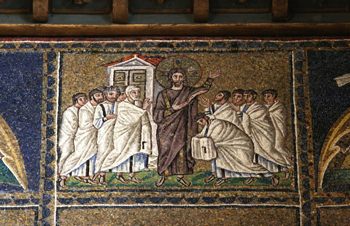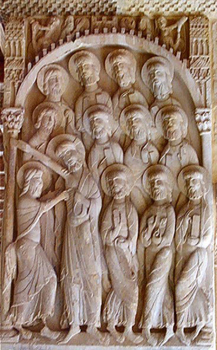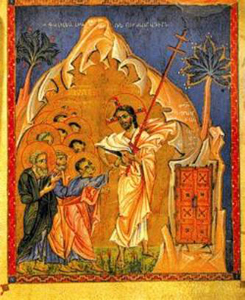For Sunday April 3, 2015
Lectionary Readings (Revised Common Lectionary, Year C)
Acts 5:27–32
Psalm 118:14–29 or Psalm 150
Revelation 1:4–8
John 20:19–31
On Easter Sunday, we Christians condensed our confession down to three words: "Christ is risen!"
Those three words are a game changer.
Without the resurrection, Jesus is just another interesting teacher. But with it, believers confess that God in Christ has defeated death and reconciled the cosmos to himself. And so the Yale historian Jaroslav Pelikan wrote, "If Christ is raised from the dead, nothing else matters. If he is not raised from the dead, nothing else matters."
"This is what we preach, and this is what you believed," Paul wrote to the Corinthians.
Paul raised the bar about as high as you can when he said that no one should believe a lie about the resurrection, and that no one should preach a lie. If Christ isn't raised, said Paul, then the first witnesses were, in Pascal's famous words, "deceived or deceivers."
 |
|
Mosaic of Doubting Thomas, Sant'Apollinare Nuovo, Ravenna, 500-520 AD.
|
This week is different. John says that he wrote his gospel with an agenda, "that you might believe that Jesus is the Christ" (20:31). But the reading this week is not about faith but about doubt — in particular, Thomas's disbelief in the resurrection.
Resurrection? Really?
Except for the times when he is grocery-listed with the other disciples, there are only three references to Thomas. They're all in John's gospel, and they all reveal Thomas's sceptical bent.
After Lazarus died, and Jesus planned to return to Judea (where villagers almost stoned him), Thomas replied, "Let us also go, that we may die with him." Then, when Jesus told his disciples that they would join him in glory, Thomas questioned him: "Lord, we don’t know where you are going, so how can we know the way?"
And then there's this week's gospel. When told that Jesus had appeared to the other disciples, Thomas was incredulous: "Unless I see the nail marks in his hands and put my finger where the nails were, and put my hand into his side, I will not believe."
The last several years, I've enjoyed reading the poetry of Denise Levertov (1923–1997). Her personal story is so interesting.
Levertov was born in England to a Welsh mother and a Russian Hasidic father. He had emigrated to the UK from Leipzig, converted to Christianity, and become an Anglican priest. After moving to the United States in 1948, Levertov taught at a number of places, including eleven years at Stanford (1982–1993). By the time she died, she had published fifty volumes.
 |
|
Carved panel of Doubting Thomas, Abbey of Santo Domingo del Silos, Spain, c. 1150.
|
It was at Stanford, where her papers are now housed, that Levertov converted to Christianity at the age of sixty. Her little book The Stream and the Sapphire collects thirty-eight poems that trace her "slow movement from agnosticism to Christian faith."
Levertov always had an affinity for Thomas the Doubter. She wrote a Mass for the Day of St. Thomas Didymus. And in The Stream and The Sapphire she included the poem St. Thomas Didymus.
The Greek Didymus and the Aramaic T'omas both mean "the twin." In her poem, though, Levertov imagines Thomas identifying with his spiritual twin rather than his biological brother.
Thomas's spiritual twin is the desperate and doubting father in Mark 9:24: "I do believe, help my unbelief."
Long after Thomas saw the miraculous healing of the little boy, the doubt of the father plagued him. "Despite all that I witnessed, his question remained my question, throbbed like a stealthy cancer, known only to doctor and patient. To others I seemed well enough."
Here is Levertov's poem:
In the hot street at noon I saw him
a small man
gray but vivid, standing forth
beyond the crowd’s buzzing
holding in desperate grip his shaking
teethgnashing son,and thought him my brother.
I heard him cry out, weeping and speak
those words,
Lord, I believe, help thou
mine unbelief,and knew him
my twin:a man whose entire being
had knotted itself
into the one tightdrawn question,
Why,
why has this child lost his childhood in suffering,
why is this child who will soon be a man
tormented, torn, twisted?
Why is he cruelly punished
who has done nothing except be born?The twin of my birth
was not so close
as that man I heard
say what my heart
sighed with each beat, my breath silently
cried in and out,
in and out.After the healing,
he, with his wondering
newly peaceful boy, receded;
no one
dwells on the gratitude, the astonished joy,
the swift
acceptance and forgetting.
I did not follow
to see their changed lives.
What I retained
was the flash of kinship.
Despite
all that I witnessed,
his question remained
my question, throbbed like a stealthy cancer,
known
only to doctor and patient. To others
I seemed well enough.So it was
that after Golgotha
my spirit in secret
lurched in the same convulsed writhings
that tore that child
before he was healed.
And after the empty tomb
when they told me that He lived, had spoken to Magdalen,
told me
that though He had passed through the door like a ghost
He had breathed on them
the breath of a living man –
even then
when hope tried with a flutter of wings
to lift me –
still, alone with myself,
my heavy cry was the same: Lord
I believe,
help thou mine unbelief.I needed
blood to tell me the truth,
the touch
of blood. Even
my sight of the dark crust of it
round the nailholes
didn’t thrust its meaning all the way through
to that manifold knot in me
that willed to possess all knowledge,
refusing to loosen
unless that insistence won
the battle I fought with lifeBut when my hand
led by His hand’s firm clasp
entered the unhealed wound,
my fingers encountering
rib-bone and pulsing heat,
what I felt was not
scalding pain, shame for my
obstinate need,
but light, light streaming
into me, over me, filling the room
as I had lived till then
in a cold cave, and now
coming forth for the first time,
the knot that bound me unravelling,
I witnessed
all things quicken to color, to form,
my question
not answered but given
its part
in a vast unfolding design lit
by a risen sun.
Not all those who saw the risen Christ believed. In his last recorded appearance in Matthew 28:17, we read that "when they saw him, they worshiped, but some were doubtful."
And not all those who believed saw him after his resurrection. Thomas was an exception, said Jesus: "Because you have seen me you believe? Blessed are those who did not see and believed."
 |
|
Armenian illuminated manuscript in the Malatia Gospel, Doubting Thomas, by Toros Roslin, 1268 AD.
|
Likewise in 1 Peter 1:8: "Though you have not seen him, you love him, and though you do not see him now, but believe in him, you greatly rejoice with joy inexpressible and full of glory."
A week later, after touching the wounds of Jesus, Thomas confessed, "My Lord and my God!"
In Levertov's poem, Thomas's questions weren't answered; they were put into a larger context and a different light.
In the end, the famous doubter became a passionate witness. The Acts of Thomas from the early third century says that Thomas took the gospel to India by 52 AD. Today, the St. Thomas Christians trace their origins to this disciple of doubt.
NOTE: For more on Levertov, see the two critical biographies by Dana Green, Denise Levertov: A Poet's Life (Chicago: University of Illinois, 2012); and Donna Krolik Hollenberg, A Poet's Revolution: The Life of Denise Levertov (Berkeley: University of California Press, 2013); and the recent Denise Levertov, Collected Poems, edited and annotated by Paul A. Lacey and Anne Dewey, with an Introduction by Eavan Boland (New York: New Directions, 2013), 1063pp.
Image credits: (1) Cloudfront.net; (2) Wikipedia.org; and (3) Wikipedia.org.



